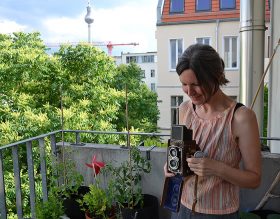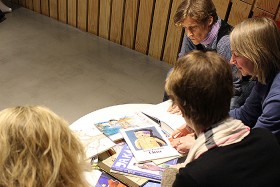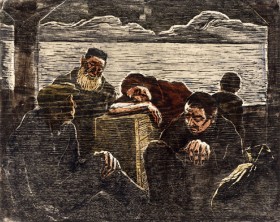A Visit to the Photographer and Architect Birgit Glatzel

Birgit Glatzel with her Rolleiflex camera; Jewish Museum Berlin, photo: Mariette Franz
It’s a warm summer’s day when I visit Birgit Glatzel in Prenzlauer Berg, the same kind of day it must have been when she shot her photograph “Angela and Me,” which, like her short film “Going to Jerusalem,” has been available in our art vending machine since April (more information on our website).
“Angela and Me” is part of a series in which the artist portrays herself with a friend in self-timed pictures. All the photographs are taken with a 1937 Rolleiflex camera, and the location and backdrop are always chosen together with the friend in question. Birgit embarked upon the project shortly before her emigration to Israel in 2007 – she wanted to take photos to remember her friends in Germany. “Memories play an important role in Judaism, for example an original piece is always left in a newly refurbished apartment,” explained the artist, who trained as an architect and works as such to earn her living. → continue reading
An Interview with Barbara Rösch about “Recommended Reading on National Socialism and the Holocaust”

Members of the reading circle © Jewish Museum Berlin, photo: Christine Marth
A German-language brochure listing “Recommended Reading on National Socialism and the Holocaust” was recently made available for download from our website as a PDF. Over the last few years several museum employees read widely on the topic, shared their opinions and then made this selection. Dr. Barbara Rösch of our Education Department talked to me about what was involved. She is a member of the reading circle and also worked for a time at the Universities of Potsdam and Leipzig as an elementary school teacher trainer. In addition to her work at the Jewish Museum Berlin she is currently writing a book about everyday racism in elementary schools.
Dear Barbara, countless books about National Socialism and the Holocaust are available for children and young people. How did you go about making a selection?
Our work is oriented primarily to the needs of teachers, who regularly ask us to make recommendations and indeed seem almost to think that we must. We therefore bear in mind the so-called “classics” that are read in German classrooms as well as new publications, books written from a non-German perspective, and books that touch upon hitherto neglected themes, such as the hakhshara movement. → continue reading
An Internet Harvest for the Day of the Refugee

“Refugees”, color woodcut by Jakob Steinhardt, 1946, purchased with funds provided by Stiftung DKLB. You can find this and other related objects in our German-language collection database.
This year’s Day of the Refugee takes place today, 2 October 2015 as part of Intercultural Week, with the slogan “Refugees Welcome!” We have taken this as an occasion to go through our own and other websites and blogs, gathering items on this subject. Since we work at a Jewish museum, stories about fleeing are part of our ‘everyday business’: practically all of the family collections given to our museum tell stories of persecution and flight, going beyond mere statistics to depict the fates of individuals. Letters, travel documents, photographs, and personal memorabilia tell of the desperate search for a country to emigrate to, failed or successful emigrations, the often difficult life in a foreign country, the search for relatives, friends, and former neighbors, now scattered across the entire world. We tell these stories in our permanent exhibition and they have also been the subject of various special exhibitions. At the moment, for instance, in our current cabinet exhibition “In a Foreign Country” you can see publications that originated in Jewish Displaced Persons Camps. Jewish men and women waited there for their passage to Palestine or later Israel, to the USA and other countries, where they hoped to start a new life after the Shoah.
In addition to our exhibitions, we also make stories of flight and displacement visible online, for example with a selection of objects: → continue reading


